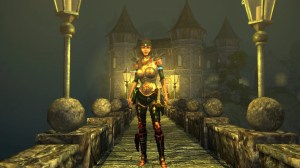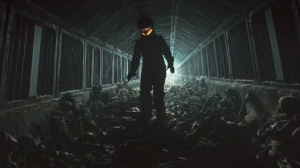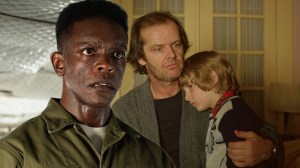Just how far did the directors of The Blair Witch Project go to torture their actors? What really happened to the town of Burkittsville, MD after the film was released? How did this film impact the hunting season following its release?
Videos by ComicBook.com
Arriving on Blu-ray this week is Blair Witch, the highly-anticipated second sequel to The Blair Witch Project. The latest film explores the mythology of the 1999 horror film that brought the concept of “found footage filmmaking” back to the world of film. The film was a unique success, thanks to the marketing campaign that everything seen in the film is actual footage, and although there have been many imitators, no film has quite caught the pop culture zeitgeist in the way Blair Witch Project did. To get there, filmmakers had to employ a heavy amount of planning to get the reactions they wanted from their actors, and there are just as many interesting behind-the-scenes stories as the story we watch unfold in the film.
In honor of the sequel’s release, which features the brother of an original character headed back to the dreaded woods to find her, learn more about how The Blair Witch Project changed the face of horror forever!
READ MORE: The Batman: 5 Great Directors That Could Replace Ben Affleck / 2016 ComicBook.com Movie Awards Vote: Best Score / 2016 ComicBook.com Movie Awards Vote: Best Visual Effects / Sci-Fi Films Whose Futures We’ve Passed
Most of the Film was Improvised
The film itself never had a traditional script, as the filmmakers relied more on the skills of their cast to tell their story. Instead, Eduardo Sánchez and Daniel Myrick gave the cast a 35-page outline on the myth of the Blair Witch, which the actors thought was a real legend. The cast would receive instructions each day on what their characters’ motivations were, each one being oblivious to one another’s instructions, and react accordingly. Some of the biggest scares of the film, like a tent being shaken and the sounds of children playing (which was audio recorded by Sánchez of his neighbors) were events the cast didn’t know would happen. One of the characters who disappeared before the end of filming didn’t know that would happen, and it was actually supposed to be a different character that disappeared, but the filmmakers thought the tension would be more authentic with the remaining two characters. Despite all this torture, the cast did have the ability to use the safeword “taco” if the experience was getting too intense.

The Cast Thought the Blair Witch was Real
The actors knew that they were filming a fictional movie, but they thought it was a fictional movie based on an actual legend. Adding more fuel to the fire of fictional figures, the cast were tasked with interviewing “townspeople” for the documentary, which they believed to be actual residents of the small town in Maryland. Rather, the filmmakers planted these interview subjects and told them what to say, making the cast believe in the legend of the Blair Witch that much more.
[H/T YouTube/Movieclips]
Filmmakers Intentionally Starved the Cast
In addition to the tough experience of shooting a movie where you’re terrorized by unseen forces in the middle of the Maryland woods, the filmmakers took small steps to physically make their cast suffer as well. The cast wasn’t physically harmed by any of the film’s experiences, but each day they were given less and less food, making them more and more irritable as each day went by, heightening the tension that was captured on film.

Took Eight Days to Shoot, Much Longer to Edit
The film had an incredibly minuscule budget, only allowing to pay the actors $1,000 a day, which made for an incredibly tight shooting schedule. The filmmakers amassed hours upon hours of footage to create a feature film, but it took eight months to put the massive project together. The first cut of the film clocked in at roughly two and a half hours, which the filmmakers eventually trimmed to be barely over 90 minutes for the final release.
[H/T YouTube/Movieclips]
Most Iconic Shot was Accidental
Towards the end of the film, Heather Donahue takes the camera and pulls it close to her face to confess how sorry she was for leading the expedition into the woods and the harm caused to the families of everyone involved. The camera is zoomed in extremely close, allowing audiences to see tears pouring snot dripping, and facial imperfections. The iconic shot has been parodied countless times, but Donahue actually had no idea how close the camera zoomed in. She thought the framing was zoomed out enough that you could see her whole face, but when filmmakers noticed the intense angle, they kept it in rather than reshooting to savor the intensity of the performance.

Found Teeth and Hair Were Authentic
In one sequence in the film, one of the investigators goes missing, never to be seen again. Instead, Heather finds a bundle of sticks wrapped in that character’s clothing, along with teeth, blood, and hair. The terrifying reveal was made all the more realistic due to the filmmakers’ choice to use real hair from the actor and actual human teeth, obtained from a dentist.
[H/T YouTube/Movieclips]
Audiences Were Supposed to See the Blair Witch
Many audiences were disappointed at the subtlety of the film, hoping that they’d get to see more of what the characters are reacting to, which is what audiences expected in the late ’90s. Those subtleties definitely worked in the film’s favor, but one sequence was intended to reveal the Blair Witch herself roaming the woods, which is what caused a scene towards the end with characters running and shouting, “Oh my God, what The f**k is that?!” The cast was seeing one of the members of the crew in the woods wearing a white gown and a ski mask, but the cast was so distraught, they never actually panned over to see the terrifying image, which cut the opportunity to see the witch from the film entirely.
[H/T YouTube/Movieclips]
Filmed With an Incredibly Different Concept
The final result of The Blair Witch Project and footage captured within it was merely meant to be one part of a bigger concept. The film was originally supposed to use footage of lost campers in conjunction with an investigative team hoping to find them that also documented the aftermath of the missing expedition. When the filmmakers watched how compelling and fascinating the footage was of just the lost campers, they cut the faux-documentary elements from the film and featured just the lost campers.

Viral Marketing
When Cannibal Holocaust was released, the marketing for the found footage horror film was so convincing that the director faced murder charges, which were dropped when the film’s cast actually appeared to prove it was all a hoax. Hoping to recreate that publicity, the filmmakers put up “Missing” flyers with photos of the cast when the film screened at Cannes Film Festival to fuel excitement about the movie. The flyers were removed the next day, as there was an actual missing persons case going on at the time, but marketing didn’t stop there. Once the film was purchased and slated for release, a website all about the events of the film popped up, which gave internet users information about the missing people, the myth of the Blair Witch, and phony “evidence.” Thanks to the lack of information on the internet in the late ’90s, disputing the evidence proved difficult, but this strategy of viral marketing has been recreated to varying degrees of success in the last 15 years, from properties like Cloverfield, Lost, and The Dark Knight inspiring audiences to do their own research and follow clues they’ve found on fake websites to learn more about the story.

Hunting Season Suffered Due to Tourists
Following the film’s release and massive success, many tourists flocked to Burkittsville to explore the woods where the movie was filmed. Some of these tourists appeared in the woods to recreate iconic sequences while others investigated what they thought was a true disappearance caught on film and searched for clues. These tourists disturbed the hunting season and also caused vandalism throughout the small town, including the official Burkittsville town sign being stolen multiple times.
[H/T YouTube/Movieclips]
One of the Most Profitable Movies of All Time
The filmmakers might have felt hindered by their measly budget of $60,000 (with some reports claiming it was even lower), that budget actually helped the film find its way into record books. Far from being the cheapest movie ever made, the film managed to pull in close to $250 million dollars, setting the bar for one of the biggest returns on investment in Hollywood history. The Blair Witch Project was considered the most profitable movie of all time for years, until another movie, made for around $15,000, went on to gross close to $200 million, giving a higher return on initial dollars spent. Unsurprisingly, that film was Paranormal Activity, another found footage horror movie that claimed the event depicted within it had actually occurred. The Blair Witch Project filmmakers were so desperate to save money that after filming completed, they returned one of the cameras used to Circuit City to get a refund. Another one of the cameras was also auctioned off on eBay, pulling in roughly $10,000, allowing more funds to be recouped.
[H/T YouTube/Moghwacy]








